Nikon D5 XQD Review
Nikon D5 XQD Performance - How well does it take pictures?
Ultimately, it is the image quality that makes a camera worth buying. For a digital SLR, image quality greatly depends on the lens used. While color, noise, contrast and exposure are properties of the camera, distortion, vignetting and chromatic aberrations are properties of the lens. Sharpness depends on the weakest link. So, the camera cannot capture more details than the lens lets through. Conversely, a lens can transmit a greater amount of details than the sensor can capture.
The new 20 megapixels full-frame CMOS sensor in the Nikon D5 boasts an unprecedented sensitivity range. The real secret is an equally improved EXPEED 5 processor which eliminates noise with minimal impact to details and image quality.
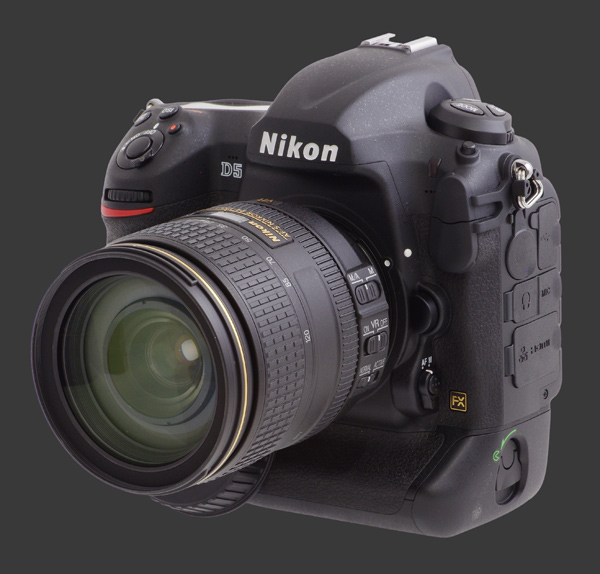
Looking at JPEG image quality paints a different story than RAW output. Images from the D5 are very clean with virtually no noise until ISO 3200. RAW files though already start showing noise at ISO 800 which is somewhat low for a full-frame sensor. It requires more effort work but noise-reduction can always be applied to RAW files after the fact as well. Maximum print sizes are possible until ISO 3200. For a 20 megapixels sensor, this means a large 14" x 21" print is easily possible. ISO 6400 still looks reasonably good at that size, just not impeccable. More standard 12" x 18" prints look fantastic though.
ISO 12800 shows some deterioration with the finest details being eaten by noise. This is for JPEG as RAW output is rather noise at this point. One can manage mid-size prints directly from in-camera images. This is some fantastic results from the EXPEED 5 image processor. Keep in mind though that noise-reduction is tunable in-camera. For most of the ISO range, a Normal setting is ideal. When reaching at the end of the standard ISO range though, it is slightly heavy-handed and Low produces better output. Too bad Nikon does not provide per-sensitivity noise-reduction control.
ISO 25600 is noisy, although noise is still confined to luminance which makes it less disruptive. Colors remain quite consistent at this level. Dynamic-range though takes a small hit, so one has to be more careful with shadow areas. Bright mid-size prints can look pretty reasonable but dark scenes should be limited to smaller print sizes. Impressively, ISO 51200 looks only a little softer than the previous stop.
The highest standard sensitivity of the Nikon D5 is 102400. At that level, noise is destructive to most details with another notable drop in dynamic-range. Still, image noise is confined to the luminance channel. This ISO remains usable for small prints but mid-size ones show evident noise.
The extended ISO range seems to be there mostly for bragging rights. ISO 204800 barely produces a recognizable image and would not be recommended unless no other option exists. Chrominance noise starts here and increases quickly with each higher ISO stop. ISO 409600 is extremely noisy with no details remaining. From ISO 819200 to 3276800, images are simply unusable. It is difficult to say what is in such images. These stellar sensitivity - even if they would work - seem to be of little practical value. Few scenes can be exposed at such extreme ISO that the camera can get an image without stopping down so much.
Image sharpness is excellent on the D5. The EXPEED 5 processor produces very sharp images even at the default setting of 3. There is some slight sharpening artifacts which are only visible when seen at 1:1 magnification. Tuning down Sharpness to 2.5 instead results in images free of artifacts. Between 2 and 3, results are very nice. Lower is quite soft and higher settings start adding outlines to edges. There is a Clarity setting which affects micro-contrast and is useful to produce more crisp images. The optimal setting for this is around +2.5 which produces detailed yet looking natural images.
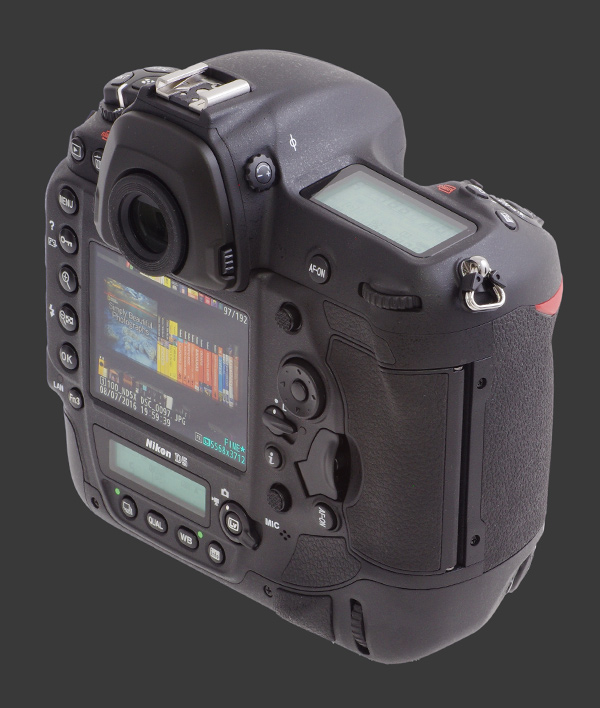
There are quite a few metering modes on this DSLR. The default Matrix metering is balanced to produce bright exposures which means slightly more frequent over-exposure happen than usual. Highlight Weighed metering is much better and highly conservative. It extremely rarely over-exposed and mostly needs a little positive exposure compensation for scenes with excessively bright highlights. Spot and Average metering work exactly as expected.
Image parameters are plentiful and adjustable with very fine steps. There are six picture styles offering various degrees of realism. The Standard style is closest to reality with natural and nicely saturated colors. More realistic output is possible by toning down Saturation to -0.5 and shifting Hue to +0.25. The Standard tone-curve is slightly harsh by default. Setting Contrast to -0.75 and Brightness to +0.5 improves shadow details while producing images with plenty of punch.
Automatic white-balance is average under most conditions but struggles somewhat under dim artificial light. There are three Auto settings that vary in how they deal with the warm color-cast typical of tungsten lighting. Unfortunately, they all leave a noticeable orange cast in images under low-light. This issue is not entirely consistent either, so using a Preset or Custom WB is recommended for such conditions.
Dynamic-range of the Nikon D5 is pretty good. Between ISO 50 and 400, it captures around 12 stops which is sufficient for most scenes yet falls short of best-in-case DSLRs. There is a very gentle drop in dynamic-range as ISO increases. So, although the D5 starts behind, it takes the lead starting at ISO 3200. From there until ISO 25600, dynamic-range starts above 8 stops which is very impressive. As one would expect, things go quickly south from there.
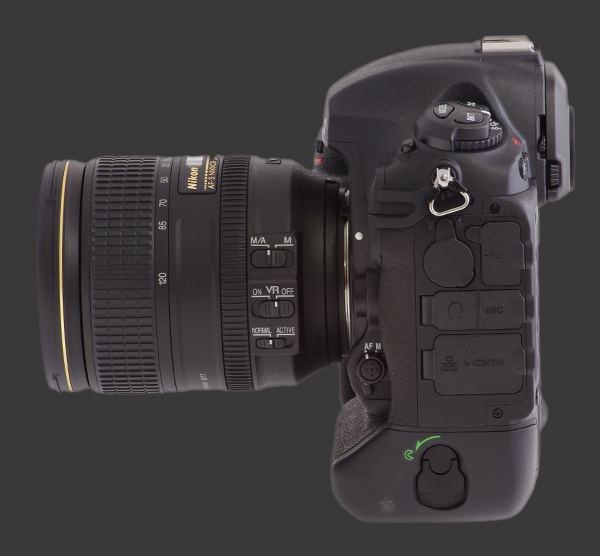
The Nikon D5 is an incredibly fast camera. Reaching a speedy 12 FPS, the continuous drive can sustain bursts up to 200 maximum quality JPEG images or 180 losslessly compressed 14-bit RAW files. This lets is shoot for 15 seconds at maximum speed without interruption. There is even a faster 14 FPS with the mirror locked up that keeps the same maximum burst length.
As mentioned in the introduction to this review, there are actually two D5 models available. The one reviewed here offers 2 XQD memory-card slots, while the other has 2 Compact Flash ones. XQD memory supports faster memory which makes the D5 XQD perform slightly better than the D5 CF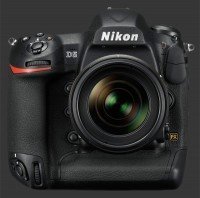
Nikon D5 CF. XQD memory cards are currently available with 400 MB/s write and 440 MB/s read speed.
Every feature and control on the Nikon D5 is responsive and lets the photographer keep working. The D5 is built for speed above all else and is characterized by the following performance numbers:
- Power On: Instant. Excellent.
- Power Off: Instant. Excellent.
- Autofocus: Under ¼s even in low light. Too fast to measure!
- Focus Confirm: Instant for both autofocus and manual focus. Excellent.
- Shutter-lag: Instant followed by extremely short black-out. Extremely good.
- Shot-to-Shot Speed: About ¼s. Excellent.
- Instant Review: Just under ½s. Average.
- Playback Mode: ¼s. Very good.
- Shooting Mode: Instant. Great.
This is an excellent performance by all counts. There is one metric which is surprisingly slower than on the D4S and that is Instant Review. The D5 features automatic distortion correction based on pre-programmed lens data. Due to the nature of optical distortion, parts of the captured image get cropped, making precise framing impossible. Enabling it also slows the camera down by adding about ¼s to the Instant Review delay.
There is also an optional Vignetting Control feature. Unfortunately, this one is not profile-based and simply applies a chosen amount of correction. Options are Off, Low, Normal and High. Although vignetting is actually very easily corrected in software without detriment to image quality, using this feature is not recommended. Vignetting varies by lens, focal-length and aperture, so it would be considerably too much work to keep adjusting Vignetting Control according for constantly changing parameters.
The new 153-point Phase-Detect AF system in the D5 is ultra-fast and barely slows down in low-light. It is extremely sensitive, down to a class-leading -4 EV, which makes it possible to automatically focus on scenes which require extreme ISO sensitivities. The accuracy of this autofocus system is highly reliable.
Battery-life is amazing at 3780 shots-per-charge according to the CIPA standard. It is more than sufficient for an intense day of professional photography. Battery-life goes down faster if the Network interface is ON, so make sure to turn it off when no longer needed. A second battery is always a good idea and Nikon provides an enormous charger which can charge two at once.
Nikon D5 XQD Performance - How well does it shoot video?
The D5 is the second Nikon to record 4K video and their first DSLR to do so. It captures 3840x2160 video at 30 FPS or 1920x1080 @ 60 FPS, giving the choice between Ultra HD for fine details or Full HD for fluid motion. Videos are stored in Quicktime format using the H.264 codec.
Full HD can be recorded using a 16:9 full-width crop of the sensor or a 3X center-crop which lets it effectively boosts magnification. Most importantly though, it avoids pixel skipping which may cause video artifacts. Ultra HD though is always recorded from a 1.5X crop. This ensures a certain level of quality at the expense of a reduced angle-of-view. It may be possible to compensate for this using a DX or third-party lens made for APS-C sensors.
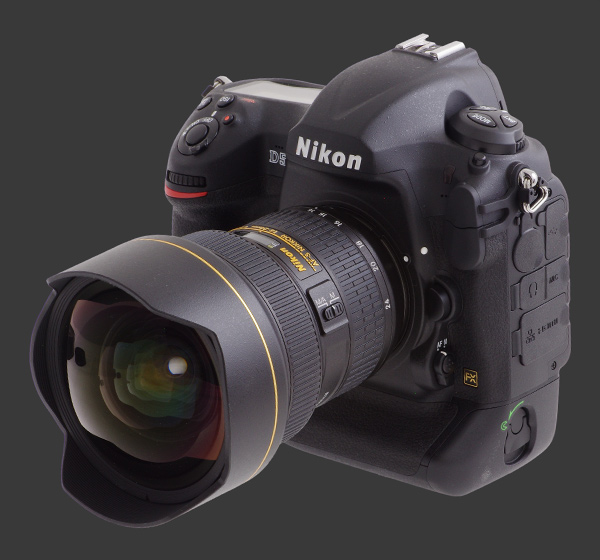
Video can be recorded with or without sound. The camera includes a built-in stereo microphone with adjustable sensitivity, either automatic or 20 user-selectable levels. Additionally, the frequency response of the microphone can be narrowed to the vocal range. Optional wind noise reduction is also available. Sound can be monitored using a head-set connected to the stereo output mini-jack. It can be recorded from an external stereo source too via another mini-jack.
This DSLR luckily features a dedicated video mode. It is activated by entering Live-View with the rotating switch set to Video. Full manual-controls are available except that ISO is on Automatic outside of M mode. Videos can be recorded to either memory card.
The Video Record button starts recording almost instantly which is a noticeable improvement compared to the D4. Pressing it again immediately stops the recording. There are two focus modes when recording video:
- AF-S: Single-shot AF which is performed each time the shutter-release is pressed half-way. The focus-area can be moved anywhere in the frame using the 8-way controller. Manual focus is also available before and during filming using any lens with an M/A mode.
- AF-F: The camera focuses continuously at all times, before and during filming. This results in audible noise which is captured by the built-in microphone. More alarming is the back-and-forth lens movement due to the nature of Contrast-Detect autofocus. Avoid this mode.
Four AF-areas options are available for video capture: Wide, Normal, Tracking and Face-Detect. If you must use AF for video, use AF-S with Normal area and perform autofocus at the least bothersome time with the focus-point positioned neatly on the desired subject. Remember that missed focus attempts will be seen in recorded video and disturb viewers which is why quality videos are normally produced using Manual Focus.
Video quality depends on a number of factors. In the headline 4K mode, the bit-rate is relatively low. When scenes are mostly static, it is quite sufficient to render fine details not visible in Full HD. While panning or tracking a moving subject though, it shows motion artifacts and details get slightly soft. Full HD obviously cannot capture as much details but its quality is much more steady. In theory, using the full sensor area should be prone to moire artifacts but it does not appear to be much of an issue.
Time-Lapse
The Nikon D5 can directly produce time-lapse videos. It is one of a handful of DSLRs which can do this at 4K. While this can be done in any mode, it only makes sense in Video mode since that is the only way to properly frame the time-lapse.
The interval between the start of exposures can be set from 1 second to 10 minutes, in one second increments. The total time to capture the time-lapse can run from 1 minute to 7 hours and 59 minutes, in one minute increments. While setting these parameters, the camera shows the length of the resulting video. The OK button can be used to interrupt the process and stores the time-lapse captured up to that point.
Any exposure-mode can be used for the time-lapse and both metering and autofocus are performed for each frame. Resulting images are scaled down and combined into a video of the selected resolution and frame-rate. The output quality is therefore comparable to video quality since it uses the same codec and compression.
Nikon D5 XQD Conclusion

The Nikon D5 is clearly a solid professional photography tool. While it headlines a new 20 megapixels CMOS sensor, EXPEED 5 image processing engine and 153-point Phase-Detect AF module, what makes it a fantastic camera is what it takes from the D4: Exceptionally fast performance and outstanding ergonomics with a very complete feature set.
Major changes compared to the D4S deserve careful consideration. The new sensor clearly produces high image quality. Noise is low and dynamic-range is pretty good, although both of these image quality metric fall short of the D4S which has larger pixels. The new processor really delivers though. Its noise-reduction appears nearly miraculous when comparing JPEG images next to RAW output. It renders details very sharply. Colors, clarity and contrast are highly tunable to taste and capable of very good realism.
The ace of the D5 is its new Phase-Detect AF system. It remains just as fast as its predecessor while providing three times more focus point, twice the sensitivity and improved accuracy. This new 153-point module is highly versatile and capable of focusing in near darkness, matching best-in-class digital cameras for low-light sensitivity while besting them in terms of speed. There is simply no other camera which can focus this fast at such low light levels.
The Nikon D5 XQD is blazingly fast. Except for Instant Review which takes a fraction of a second longer than its predecessor, every speed metric is nearly class-leading. This camera never holds the photographer back and is always ready to shoot. The XQD bus lets it clear its deep 200-image buffer extremely quickly. Even 4K Ultra-HD video get stored in a flash.
Ergonomics of this professional DSLR are excellent. Nikon made several key improvements though which truly make a difference without losing the familiarity of previous models. The more distinct ISO button and modeless drive mode setting are the key to this success. The D5 interface is more customizable than before which allows more critical functions to remain accessible. This thankfully includes Shutter-Delay which can now be bound to one of the function buttons. The new ultra-high-resolution 2.4 megapixels LCD is also quite impressive.
Where the Nikon D5 makes the most sense is for low-light action photography thanks to its combination of extreme high-ISO and highly sensitive AF. Indoor sport photographers are certain to enjoy what the D5 delivers.
 |
Please Support Neocamera
All information on Neocamera is provided free of charge yet running this website is a huge endeavor. Purchases made via affiliate links found throughout the site help keep it running and up-to-date. There is no additional cost to you, so please consider buying via these links to our affilates:
If you found any information on this site valuable and did not purchase via our affiliate links, please considering donating via PayPal:
Any amount will be greatly appreaciated. Thank you for your support!
Nikon D5 XQD Highlights

Sensor-Size: 36 x 24mm

Actual size when viewed at 100 DPI
| 20 Megapixels DSLR | ISO 100-3280000 |
| Nikon F Mount 1X FLM | Shutter 1/8000-30s |
| 100% Coverage Extra Large Viewfinder | Full manual controls, including Manual Focus |
| 2 Axis Digital Level | Custom white-balance with 2 axis fine-tuning |
| Weatherproof | Spot-Metering |
| Built-in Dust Reduction | Hot-Shoe & Sync-Port |
| 12 FPS Drive, 200 Images | Stereo audio input |
| 3840x2160 @ 30 FPS Video Recording | Lithium-Ion Battery |
| 3.2" LCD 2.4 Megapixels | XQD x 2 CF Express Type B x 2 |
Updates
2024.04.03

Fujifilm X-T5 Review
Newest Fujifilm flagship boasting a 40 MP APS-C sensor, 5-axis IBIS with 7-stop efficiency, 15 FPS continuous drive, 6.2K Video capture, dual control-dials and dual SDXC UHS-II slots in a sturdy weatherproof and freezeproof body.
2023.11.20

Best Digital Cameras of 2023
Find out which are the Best Digital Cameras of 2023. All the new Mirrorless Digital Cameras from entry-level to high-end professional.
2023.07.10

Fujifilm X-H2 Review
40 Megapixels APS-C Hybrid Mirrorless Digital Camera with 7-stop IBIS. Fastest shutter ever and 8K video capture. Large builtin EVF with 0.8X magnification and 5.8 MP, plus an Eye-Start Sensor. Packed with features and large number of controls in a weatherproof and freezeproof body.
2023.05.07

Sony FE 20-70mm F/4G Review
Review of the unique Sony FE 20-70mm F/4G lens. The optical zoom of this lens spans ultra-wide-angle and medium focal-length coverage, making it one of the most versatile Full-Frame lenses on the market.
2023.01.15

Huion Inspiroy Dial 2 Review
Review of the Huion Inspiroy Dial 2 tablet, a medium sized drawing surface with dual dials and customizable buttons. Connects via USB-C or Bluetooth 5.0 with Windows, Linux and Android support.
2022.12.08

How to Pack for a Photo Trip
Find out how to pack for a travel photography trip, carry your gear safely while meeting airline regulations.
2022.11.13

Best Digital Cameras of 2022
The best digital cameras of 2022. A short list of the most outstanding models in their respective categories. Choose one for yourself or as a gift.
2022.09.21

Pentax DA* 60-250mm F/4 SDM Review
Review of the Pentax DA* 60-250mm F/4 SDM, the constant-aperture telephoto zoom with the highest zoom-ratio on the market.
2022.09.20

Pentax DA* 50-135mm F/2.8 SDM Review
Review of the Pentax DA* 50-135mm F/2.8 SDM, the lightest professional telephoto zoom native to the K-mount.
2022.09.10

Pentax DA* 11-18mm F/2.8 DC AW Review
Review of the Pentax DA* 11-18mm F/2.8 DC AW, the widest professional ultra-wide zoom native to the K-mount.
2021.11.24

50 Gifts Under $50 For Photographers in 2021
50 Gifts photographers will love. All for under $50 USD. 2021 Edition.
2021.11.17

Best Digital Cameras for 2021
Neocamera shows which are the very best Digital Cameras for 2021 in every category: Mirrorless, DSLR, Premium Compact, Ultra-Zoom and Rugged.












